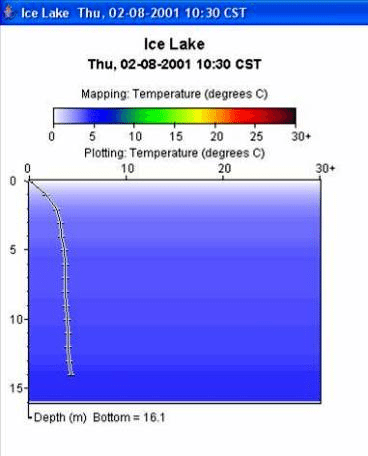 Everybody likes to talk about thermoclines and summer stratification, but winter has its own unique water properties worth discussing. Since many lakes in the northern part of the country will begin freezing in the very near future, I thought it would be an appropriate topic. Water is most dense at 39.6 degrees F. Once lake water reaches that temperature throughout its water column, things start happening in reverse from what occurred in summer. As water cools further, the warmer more dense water stays down on the bottom of the lake and forces cooler, less dense water to the surface. At some point you end up with ice, which occurs at 32 degrees F. This is also why once your lake reaches 39 degrees F., it is almost the equivalent of liquid ice. It takes very little to go from 38 to 32 degrees (ice), and is why you can wake up one morning and have skim ice covering an entire lake. Here is a cool data capture showing this phenomenon from “Ice Lake” in Minnesota appropriately enough.
Everybody likes to talk about thermoclines and summer stratification, but winter has its own unique water properties worth discussing. Since many lakes in the northern part of the country will begin freezing in the very near future, I thought it would be an appropriate topic. Water is most dense at 39.6 degrees F. Once lake water reaches that temperature throughout its water column, things start happening in reverse from what occurred in summer. As water cools further, the warmer more dense water stays down on the bottom of the lake and forces cooler, less dense water to the surface. At some point you end up with ice, which occurs at 32 degrees F. This is also why once your lake reaches 39 degrees F., it is almost the equivalent of liquid ice. It takes very little to go from 38 to 32 degrees (ice), and is why you can wake up one morning and have skim ice covering an entire lake. Here is a cool data capture showing this phenomenon from “Ice Lake” in Minnesota appropriately enough.
Here you can see what goes on under the ice in nearly every body of water (lake/reservoir) that freezes. You’ll notice the 4.2 Centigrade (39.6 F) temp at the bottom of the profile in nearly 45 feet of water. You have to rise up to 13′ feet (4 m) to reach 3.2 deg. Centrigrade (37.8 F). Cut that in half to the 2 meter (6.5′) mark and you cool to 2.7 deg. Centigrade (36.9 F). At 1 meter (~3′) you cool to 1.7 deg. Centigrade (35.0 F). Finally at the surface you have ice (0 deg. Centigrade or 32 deg. F).
So you basically have a fairly stable water column below 15′ all the way to the bottom of the reservoir composed of the warmest water in the lake. This is why you’ll typically find fish at their deepest point of the year in early winter. This is especially true if you fish a lake with a shad base for forage, as they seek out the warmest water (with oxygen) in an effort to try and survive the winter. And, with rapid warming from 32 on the surface to 38 degrees just 10-15′ down, that fast temperature increase in the top 2 meters of water technically qualifies as a thermocline on an absolute basis, hence the concept of a spring turnover. It certainly isn’t as dramatic as a fall turnover, but an entire water column mixing none the less.
























